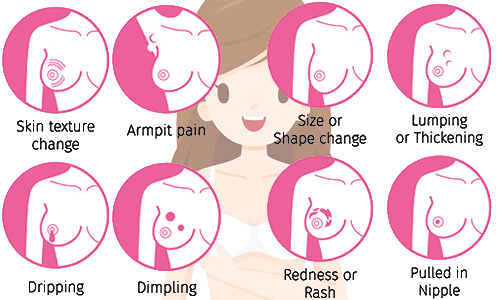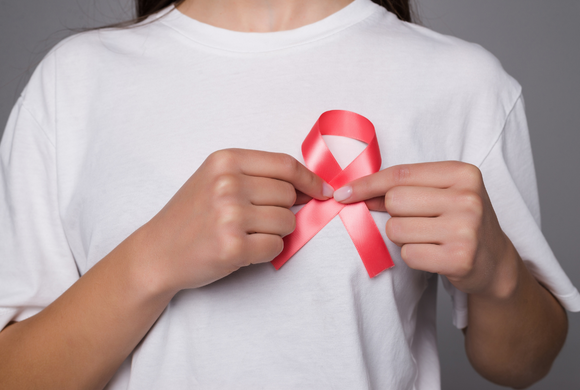Breast cancer remains a significant concern worldwide, and in India, it is the most common cancer among women, accounting for 25-32% of all female cancers. Each year, one woman is diagnosed every four minutes with breast cancer in India, and it is estimated that the incidence will increase by 12.8% by 2025. In this blog, we will discuss breast cancer symptoms and treatments in detail.
A breast comprises three main parts: lobules, ducts, and connective tissue. Most breast cancers begin in the ducts or lobules and spread to other parts.
There are several breast cancer risk factors. Some of them, like unhealthy food habits, can be changed. Regular exercise helps prevent breast cancer to some extent. Others, such as genes and hormonal modifications, cannot be reversed or changed. Being aware of the risk factors, breast self-exam guidelines, and the signs and symptoms can go a long way in the early detection of the disease in women.
Symptoms of Breast Cancer
You can try to reduce the risk of breast cancer in several ways. You can consume some of the 15 superfoods to reduce the risk of breast cancer. However, people who follow healthy diets and exercise regularly might also have cancerous growths in their breasts.
Many women with breast cancer may not show symptoms early on, which makes regular screening crucial. Due to late detection, more than 70% of breast cancer cases in India are diagnosed at advanced stages (Stage 3 or 4). Often, the very first symptom of breast cancer will be a lump in the breast or underarm, which might be painless, followed by bloody discharge from the nipple and changes in the shape or texture of the nipple or breast. The symptoms may also include…
- Irritation or dimpling of the breast skin (which makes it look like an orange peel)
- Inverted nipple
- Redness and discomfort in the breast
- Soreness
- Rash

Many people with breast cancer might not show any symptoms at all. This is the reason why it’s difficult to diagnose breast cancer in its early stages. However, early breast cancer detection is crucial because patients have a better chance of recovery in such cases.
Sometimes, you can only notice the symptoms after two to five years, as it takes 28 cell divisions for them to be felt or seen, and each division takes one to two months.
“Invasive breast cancer” is a type of breast cancer where the cancer cells take root in the glands or ducts and then spread to the surrounding breast tissue. It is also known as “invasive mammary carcinoma.”
Early Signs of Breast Cancer
The risk of breast cancer increases with age, especially in women between 50-64 years. However, urban women are at higher risk (1 in 22) than their rural counterparts (1 in 60). Despite lifestyle adjustments and healthy habits, awareness and self-examination are essential for early detection.
Women must know the normal look and feel of their breasts so that they will be quick to notice any changes in them, if any. Knowing the texture and feel of the breasts is also essential to maintaining breast health.
It’s quite unusual for breast cancer to cause any pain. If you think, “What are the reasons for breast pain?” there’s a long list of answers. However, only 1%–5% of women have serious symptoms of breast cancer.

If you notice any of the following signs, it’s time to get a mammogram.
- Nipple retraction: the nipple turns inward
- Swollen lymph nodes: these can be seen close to your collarbone or under your arms
- Thickened breast or nipple skin
- Flaky breast skin
Mammogram for Breast Cancer
Mammograms are X-ray examinations of the breasts. When it’s done on a woman who shows no signs or symptoms of breast cancer, it’s known as a “screening mammogram.” But when it’s done on a person who shows some sign of breast cancer, like a lump, it’s called a “diagnostic mammogram.”
Breast Cancer Treatment Options
The five-year survival rate for breast cancer patients in India is 66.4%, lower compared to developed countries due to challenges with early detection and access to quality treatment. Urban areas, such as Mizoram, report survival rates up to 74.9%, while rural regions, like Pasighat, show survival rates as low as 41.9%
Breast cancer stages play a crucial role in deciding the type of treatment. Doctors usually suggest one of the following types of treatments:
1. Surgery
There are different types of surgeries in which the tumour cells are removed. Some of them are
- Lumpectomy
- Mastectomy
- Sentinel Node Biopsy
- Axillary Lymph Node Dissection (ALND)
- Contralateral Prophylactic Mastectomy (CPM)
2. Chemotherapy
Doctors recommend chemotherapy before surgery with the idea of shrinking the tumour, as it makes it easier to remove the tumour. Chemotherapy sessions can cause several changes in a person’s body.
3. Radiation Therapy
High-power radiation beams are used to radiate and kill cancer cells. External radiation beam therapy is a type of local treatment that aims directly at the spot of your cancer cells. This therapy destroys the genetic material that controls cell growth and division.
4. Hormone Therapy
Also called endocrine therapy, this breast cancer treatment option is used among hormone receptor-positive cancer patients. Breast cancer cells grow with the help of hormones like estrogen and progesterone. Doctors mostly use hormone therapy after surgery to reduce the risk of cancer returning.
In addition to the above, immunotherapy is one of the emerging treatment options for cancer.
Different Stages of Breast Cancer
Stage 0
Non-invasive breast cancer, or ductal carcinoma in situ (DCIS), restricts the cancer cells to the milk ducts. Treatment options include surgery, radiation therapy, and hormone therapies.
Stage 1
Surgery is the best option as the tumour is about 2 centimetres or less than that. The axillary lymph nodes are not affected, making them easier to remove. Doctors consider stage 1 as the early stage of breast cancer; hence, they recommend surgery or radiation therapy.
Stage 2
The tumour might have spread across one or three lymph nodes. During this stage, you’ll probably need a combination of surgery like chemotherapy and radiation therapy or hormone therapy.
Stage 3
This stage is a bit riskier; hence, it involves a combination of treatments like surgery, systemic therapy, chemotherapy, and radiation therapy.
Stage 4
People under stage 4 are fundamentally treated with systemic therapy, which includes treatments like chemotherapy, hormonal therapy, or targeted therapy.
Breast Cancer and Self-Esteem

It’s important to highlight the need for regular mammograms and self-examinations for all women, as timely detection drastically improves survival chances. By 2025, the projected increase in cancer cases highlights the urgency to spread awareness and ensure access to timely healthcare across the country. We understand that breast cancer detection can be devastating to a person and their family members. However, there are many survivors who have faced and battled it with strength and hope. Caring for your body during breast cancer and maintaining self-esteem is crucial. I hope this blog has helped you understand breast cancer symptoms and treatments better.

